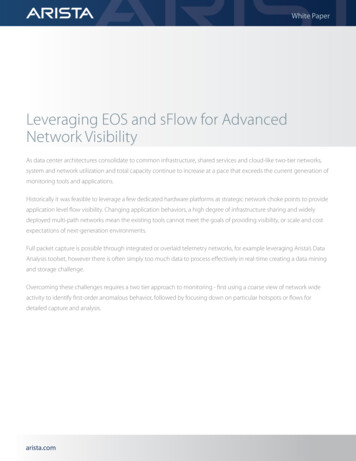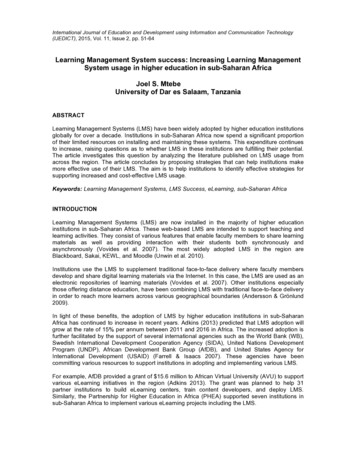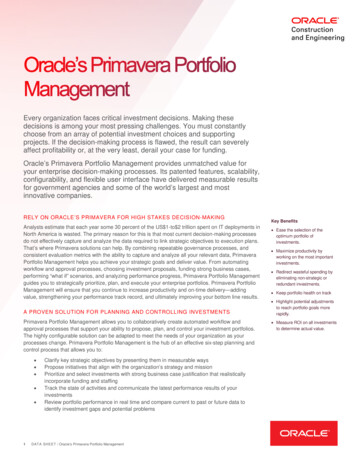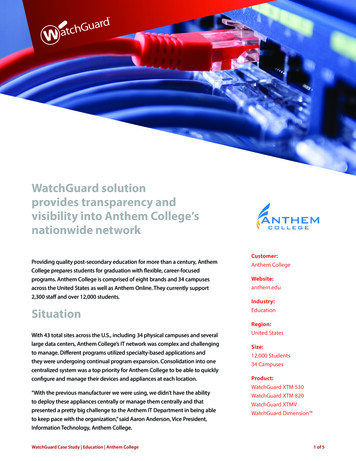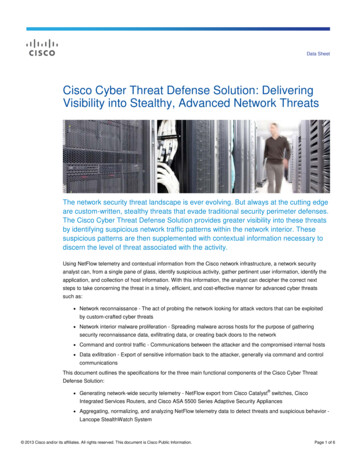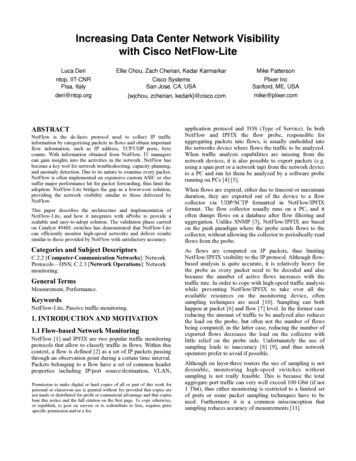
Transcription
Increasing Data Center Network Visibilitywith Cisco NetFlow-LiteLuca Derintop, IIT-CNRPisa, Italyderi@ntop.orgEllie Chou, Zach Cherian, Kedar KarmarkarCisco SystemsSan Jose, CA, USA{wjchou, zcherian, kedark}@cisco.comABSTRACTNetFlow is the de-facto protocol used to collect IP trafficinformation by categorizing packets in flows and obtain importantflow information, such as IP address, TCP/UDP ports, bytecounts. With information obtained from NetFlow, IT managerscan gain insights into the activities in the network. NetFlow hasbecome a key tool for network troubleshooting, capacity planning,and anomaly detection. Due to its nature to examine every packet,NetFlow is often implemented on expensive custom ASIC or elsesuffer major performance hit for packet forwarding, thus limit theadoption. NetFlow-Lite bridges the gap as a lower-cost solution,providing the network visibility similar to those delivered byNetFlow.This paper describes the architecture and implementation ofNetFlow-Lite, and how it integrates with nProbe to provide ascalable and easy-to-adopt solution. The validation phase carriedon Catalyst 4948E switches has demonstrated that NetFlow-Litecan efficiently monitor high-speed networks and deliver resultssimilar to those provided by NetFlow with satisfactory accuracy.Categories and Subject DescriptorsC.2.2 [Computer-Communication Networks]: NetworkProtocols—DNS; C.2.3 [Network Operations]: Networkmonitoring.General TermsMeasurement, Performance.KeywordsNetFlow-Lite, Passive traffic monitoring.1. INTRODUCTION AND MOTIVATION1.1 Flow-based Network MonitoringNetFlow [1] and IPFIX are two popular traffic monitoringprotocols that allow to classify traffic in flows. Within thiscontext, a flow is defined [2] as a set of IP packets passingthrough an observation point during a certain time interval.Packets belonging to a flow have a set of common headerproperties including IP/port source/destination, VLAN,Permission to make digital or hard copies of all or part of this work forpersonal or classroom use is granted without fee provided that copies arenot made or distributed for profit or commercial advantage and that copiesbear this notice and the full citation on the first page. To copy otherwise,or republish, to post on servers or to redistribute to lists, requires priorspecific permission and/or a fee.Mike PattersonPlixer IncSanford, ME, USAmike@plixer.comapplication protocol and TOS (Type of Service). In bothNetFlow and IPFIX the flow probe, responsible foraggregating packets into flows, is usually embedded intothe networks device where flows the traffic to be analyzed.When traffic analysis capabilities are missing from thenetwork devices, it is also possible to export packets (e.g.using a span port or a network tap) from the network deviceto a PC and run let them be analyzed by a software proberunning on PCs [4] [5].When flows are expired, either due to timeout or maximumduration, they are exported out of the device to a flowcollector via UDP/SCTP formatted in NetFlow/IPFIXformat. The flow collector usually runs on a PC, and itoften dumps flows on a database after flow filtering andaggregation. Unlike SNMP [3], NetFlow/IPFIX are basedon the push paradigm where the probe sends flows to thecollector, without allowing the collector to periodically readflows from the probe.As flows are computed on IP packets, thus limitingNetFlow/IPFIX visibility to the IP protocol. Although flowbased analysis is quite accurate, it is relatively heavy forthe probe as every packet need to be decoded and alsobecause the number of active flows increases with thetraffic rate. In order to cope with high-speed traffic analysiswhile preventing NetFlow/IPFIX to take over all theavailable resources on the monitoring device, oftensampling techniques are used [10]. Sampling can bothhappen at packet [6] and flow [7] level. In the former casereducing the amount of traffic to be analyzed also reducesthe load on the probe, but often not the number of flowsbeing computed; in the latter case, reducing the number ofexported flows decreases the load on the collector withlittle relief on the probe side. Unfortunately the use ofsampling leads to inaccuracy [8] [9], and thus networkoperators prefer to avoid if possible.Although on layer-three routers the use of sampling is notdesirable, monitoring high-speed switches withoutsampling is not really feasible. This is because the totalaggregate port traffic can very well exceed 100 Gbit (if not1 Tbit), thus either monitoring is restricted to a limited setof ports or some packet sampling techniques have to beused. Furthermore it is a common misconception thatsampling reduces accuracy of measurements [11].
1.2 MotivationIn today’s complex network environment, applications withdiverse purposes converge on common networkinfrastructure, users from different geographic locationsconnect to the same physical network through differentmethods. As a result of that, having the visibility into thenetwork activities and application traffic is critical to manyIT managers.For years people have been using NetFlow to gain insightinto the network traffic. However, NetFlow is not alwaysan available option. In some places in network, thenetworking gear is often not equipped with such capabilitydue to the architecture design and cost structure to fit intothat specific market, for example data center ToR switches.Flexible NetFlow is an evolution of NetFlow. It utilizes theextensible format of NetFlow version 9 or IPFIX and hasthe ability to export not only the key fields seen intraditional NetFlow, but also the new fields such as packetsection. Flexible NetFlow also introduces the concept ofimmediate cache which allows immediate export of flowinformation without hosting a local cache. NetFlow-lite[13] is built upon the flexibility of Flexible NetFlow, withthe combination of packet sampling, to offer the visibilitysimilar to those delivered by NetFlow at a lower pricepoint, without the use of expensive customer ASIC whilemaintaining the packet forwarding performance.Due to the pervasiveness of NetFlow in many parts of thenetwork, the solution also needs to be designed to integrateeasily with existing infrastructure that is already monitoringthrough NetFlow. In addition, the solution needs to bescalable in order to accommodate the rapid growth oftoday’s network, especially in mega-scale data centers(MSDCs), where thousands of servers are connected toprovide the application services to scale to the businessneeds. One challenge that arises when monitoringnetworking devices with a centralized collector/analyzer isthe extra amount of traffic it generates and traversesthrough the network. Not only does valuable bandwidthbeing taken up, but also the centralized collector might notbe able to scale up to meet the demands.This is where the NetFlow-lite converter, such as nProbe,fits in. It bridges the world between NetFlow-lite andNetFlow. It parses the packet section exported throughNetFlow version 9 or IPFIX format, extracts keyinformation such as src/dst IP address, TCP/UDP port,packet length, etc., it constructs temporary flow cache,extrapolate flow statistics by correlating sampling rate w/sampled packets, exports aggregated and extrapolated datato NetFlow collectors in standard IPFIX or NetFlow v5/v9format. With this solution, the valuable forwardingbandwidth is conserved by aggregating NetFlow-lite data tomore bandwidth efficient NetFlow exportIn a nutshell, NetFlow-Lite is a technology that providesvisibility in the data center as it enables networkadministrators to: Know what applications are consuming bandwidth, whois using them, when they are being used, what activitiesare prevalent. Have visibility and control of the network. Gather data for network and capacity planning. Troubleshoot issues. Implement network forensics.The rest of the paper is organized as follows. Section twodescribes the NetFlow-Lite architecture and flow format.Section three covers NetFlow-Lite implementation both onthe switch and collector side. Section four describes howthe implementation has been validated against real traffic.Finally open issues and future work are described onsection five.2. NETFLOW-LITE2.1 ArchitectureIn essence, the NetFlow-lite solution consists of threeelements: The switches that supports NetFlow-lite functionality andchurn out NetFlow-lite data. The converter that aggregates the data into formatunderstandable by NetFlow collectors in today’s marketplace The NetFlow collector that collects and analyzes not onlyinformation originated through NetFlow-lite, but alsoNetFlow data gathered from different parts of thenetwork, all through standard IPFIX format (or NetFlowversion 9).The converter implements the flow cache by populating itusing the sample packets stored on the received flows, andnot doing a simple 1:1 flow format conversion. It thenexports the flows in standard NetFlow V5/V9/IPFIX to astandard NetFlow collector. In a nutshell, the NetFlow-Liteconverter acts as a flow collector with respect to the switchas it collects NetFlow-Lite flows, and as a probe for theflow collector.IPFIX/V9 NetFlow-LiteNetFlow-Lite SwitchNetFlow-Lite - NetFlow/IPFIXConverterIPFIX/V9 /V5Standard NetFlow/IPFIX CollectorFigure 1. NetFlow-Lite ArchitectureIn order to preserve bandwidth usage for links on the pathbetween the switches and the converter, an option is beingprovided to specify the number of bytes in the raw packetsection that will be included in the export packet. Inaddition, it is preferable that the converter is located nearthe switch in order to avoid taking up extra forwarding
bandwidth.Netflow-LiteConverterAny NetFlowCollectorrecord within an export packet does not necessarilyindicate the format of data records within that samepacket. A collector application must cache any templaterecords received, and then parse any data records itencounters by locating the appropriate template recordwithin the cache. Data FlowSet: a collection of one or more data recordsthat have been grouped together in an export packet.Netflow-Lite 1:NPacket SamplingNetFlow v9 orIPFIX ExportFigure 2. NetFlow-Lite Enabled Data CenterArchitectureThe figure above shows a NetFlow-lite enabled data centerarchitecture, where NetFlow-lite samples incoming trafficon the TOR (top of rack) switches. The converter sitsbetween NetFlow-lite capable switches and NetFlowcollectors, extracting the information from the raw packetsection, such as IP address, TCP/UDP ports, etc. andaggregate them into a local flow cache. The flow cache canbe exported to any existing NetFlow collector for analysisand correlating.With larger data center, a zonal design is recommended. Inthat case, a converter is placed per “zone” to be responsiblefor aggregating and converting NetFlow-lite packets withinthe zone. Converters from different zones can be feedingthe aggregated NetFlow data into a centralized NetFlowcollector in order to achieve a data center-wide networkvisibility.2.2 Flow FormatA switch with Netflow-lite functionality observes ingresstraffic and sample packets at 1-in-N rate at the monitoringpoint, for example, an interface on the switch. The sampledpackets are exported in standard NetFlow version 9 orIPFIX format. IPFIX and NetFlow version 9 differs fromprevious version in that it is template-based. Templateallows the design of extensible record format. Figure 3shows the NetFlow version 9 format.Figure 3. NetFlow v9 FormatIt consists of: Template FlowSet: a collection of one or more templaterecords that have been grouped together in an exportpacket. Template record used to define the format of subsequentdata records that may be received in current or futureexport packets. It is important to note that a template Data record: it provides information about an IP flow thatexists on the device that produced an export packet. Eachgroup of data records (that is, each data FlowSet)references a previously transmitted template ID, whichcan be used to parse the data contained within therecords. Options template: a special type of template record usedto communicate the format of data related to the NetFlowprocess. Options data record: a special type of data record (basedon an options template) with a reserved template ID thatprovides information about the NetFlow process itself.One of the capabilities of this extensible design is to allowthe export of raw packet sections in the Data Record, whichfacilitates the export of NetFlow-lite sampled packets.NetFlow-Lite enabled switches exports three differenttemplates that contain: Data template that describes the structure of sampledpacket export by the switch. Options template that describes the structure of samplerconfiguration data. Options template that describes the structure of interfaceindex mapping data.The options template describing the sampler configurationessentially exports the structure of the following pieces ofinformation: An identifier for a given sampler configuration. The type of packet sampling algorithm that is employed(currently 1-in-N packet sampling). The length of the packet section extracted from the inputsampled packet. The offset in the input sampled packet from where thepacket section is extracted.Templates are exported by default every 30 minutes, andthey can be packed into a single export packet for reducingthe number of transmitted packets.L2 HeaderL3 HeaderUDP Header42 Bytes (IPv4) / 62 Bytes (IPv6)Sampled Flow Datagram84 Bytes Truncated SampleFigure 4. NetFlow-Lite Sampled Flow Datagram
From the flow format point of view, NetFlow-Lite flowsare standard V9/IPFIX flows defined using a template. theycontain packet section and other sampling parameters, butnot the traditional fields such as source/destination IPaddress. In order to bridge between NetFlow-lite andNetFlow, and integrate NetFlow-lite into existing NetFlowsolution, a converter is necessary in order to convert theinformation contained inside packet section, such as source/destination IP, TCP port, etc., into format understandable bythe NetFlow collector on the market today.NetFlow-Lite switches can adapt the sampling rateaccording to the switch port. This means that networkmanagers can provide precise monitoring of selected switchports by disabling sampling (i.e. 1-to-1 sampling rate),while using a higher sampling rate for all remaining ports.The use of the standard V9/IPFIX format preventsNetFlow-Lite converters to support a custom exportprotocol, while allowing them to be deployed anywhere inthe network as long as they are reachable via IP. Anotheradvantage is that future changes and extensions to the flowformat, do not require changes on the collector as newfields can be accommodated into the exported flows simplymy defining them into the exported template.Flow conversion is transparent to existing NetFlow/IPFIXcollectors and back-end tools. The use of sampling allowsNetFlow-Lite to scale both in terms of number of ports andpackets being monitored. Sampling rate can be adaptedaccording to various parameters such as the total number ofpackets that are collected by a converter and also thenumber of switch exporters per converter.3. IMPLEMENTATIONDue to its probe/converter architecture, supportingNetFlow-Lite has required both to enhance the switch andcreate the converter. No changes have been necessary onthe collector side, as the converter emits standard flows inv5, v9 and IPFIX format.3.1 Switch ImplementationOn Cisco Catalyst 4948E switch, the sampling rate atwhich input packets are sampled is based on userconfiguration. The switch supports extremely (low) goodsampling rate which allows for high quality of trafficmonitoring. The sampling and export are both done inhardware, which does not put heavy load on control plane.Each sampled packet is exported as a separate NetFlowdata record in NetFlow v9 or IPFIX format.The switch implements a relatively inexpensive and not sostateful way of doing packet sampling and netflow exportin hardware. The switch makes copies of the packetscoming in and being forwarded through the switch, usingappropriate rules in the classification engine that identifypackets coming from monitored interfaces. The originalpacket undergoes normal forwarding and switchingtreatment through the device. The copies undergo a twolevel sampling process.At the first level, the copies of packets from variousmonitored interfaces are generated and sent to a transmitqueue where a credit rate limiting scheme is applied. Thiscredit rate mechanism is called DBL (Dynamic BufferLimiting) and is proprietary to the Cisco Catalyst switches.DBL is used as an active queue management mechanismnormally on the switch but in this case it is ingeniouslybeing used for first level selection of sampled packets.DBL credits are applied to a monitor and refreshed in atime based fashion that allows enqueue of packets to thetransmit queue such that there are enough packets from amonitored interface to match the user configured samplingrate. Whenever a packet from a monitor is enqueued to thetransmit queue, the credits for that monitor getdecremented. The credit lookup is done through a hashingscheme that can take as input various packet fields andinput port. This effectively provides the ability to samplepackets as if on the input before packets from variousmonitors aggregate into the transmit queue.The DBL credits and refresh frequency take into accountthe average packet size observed at a given monitor. Usersmay override the observed average packet size at a monitorand configure an average packet size for a monitor via CLI.The system will then use that average packet size incomputing credits for traffic seen by that monitor.Traffic flows from each monitor are isolated from traffic onother monitors because the DBL hash key masks are basedonly on the incoming interface or VLAN ID for port andvlan monitors respectively.From the transmit queue the sampled packets are fed to aFPGA which does final sampling for packets from eachmonitor to eliminate extra samples. They are then exportedin NetFlow version 9 or IPFIX format, assisted by theFPGA.The combination of high sampling rate and userconfigurable options provide a highly accurate sampling forNetFlow-lite. The hardware-assisted sampling and exportoffer a scalable solution with minimal impact to the controlplane.3.2 NetFlow-Lite Converter ImplementationThe NetFlow-Lite converter has been implemented as anextension to nProbe [4], an open-source NetFlow/IPFIXprobe/collector developed by one of the authors availablefor both Unix and Windows systems. As stated before, theflows emitted by the switch to the exporter are followingthe v9/IPFIX guidelines thus from the flow format point ofview no changes have been necessary. The main changes innProbe have been: Ability to interpret the received NetFlow-lite flows. Extract the packet samples. Use samples to populate the flow cache.In addition to packet samples, the flows emitted by theswitch contain additional information that is necessary toproperly support NetFlow-Lite, including: The sampler named and id (configured into theswitch)that has sampled the packet.
The original packet length before cutting it to thespecified snaplen. The packet offset of the received sample, as the switchcan be configured to emit sampled packet starting from aspecific offset (the default is 0) after the ethernet header. The switch interface on which the packet has beensampled.Switch samplers are responsible to select packet to sample.A switch can define many samplers, and thus each switchport can potentially have a specific sampler. This allows forinstance to have a per-port sampling rate, but it requires theconverter to store this information as the received samplesneed to be scaled based on the sampler that has emittedthem.In order to enhance the exporter performance, it is possibleto configure the switch to send flows to a pool of UDPports and not to a single one
with Cisco NetFlow-Lite . A switch with Netflow-lite functionality observes ingress traffic and sample packets at 1-in-N rate at the monitoring point, for example, an interface on the switch. The sampled packets are exported in standard NetFlow version 9 or IPFIX format. .

